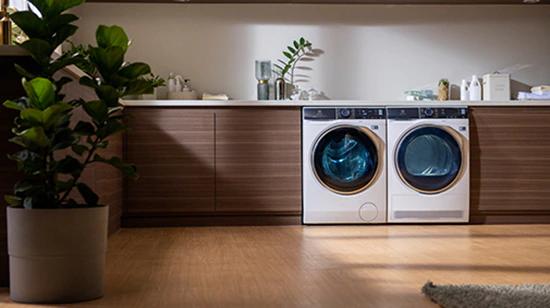A decade ago 5kg/6kg of dry clothes for the main cotton cycle, was the norm. Now yawning 10kg rated washing machines are widely available and 7kg/8kg is regarded as commonplace for a family machine for two adults and two kids. The vital thing to remember is that running a full machine is not only efficient, but a full load balances the drum properly during the spin cycle (preventing banging and the machine dancing out of position). The Which (UK) load measurement is in bath towels, but I think the duvet measurement is easier to follow.
A 6kg machine will manage a single duvet, a 7kg a double, whereas a 9kg machine will take a medium-weight king-size duvet in one gulp. How’s your current washer managing with a full load that still allow your hand to sit side-on on the top of the pile? Put in 80% as a guide. Over-loading a machine will lead to inconsistent results and will prevent detergent spread. With longer 40C Eco-cycles, a wait for two loads with an undersized machine can be as much as six hours plus.
Washer/dryers generally have a smaller capacity for the drying cycle, and you will have to decant some clothes before that second run. With washers check the capacity of individual programs, which can be less that the aggregate kg capacity of the machine.
DRUM DESIGN AND SPIN SPEED
Any drum on the store floor will wash clothes reasonably well, but some have technology boasted to do a better job. LG, 6 Motion Direct Drive technology moves the wash drum in multiple directions to “scrub, step, tumble, filter, swing and roll”. Don’t get too caught up 10 motions in a sensual, slow-mo marketing videos of drum paddles, pulsators and wave engineering. Read real customer reviews which are short on prose and heavy in indignation if a German washer doesn’t deliver blinding whites in a Teutonic flash.
We tend to get in a lather over spin speed, but it’s a washer, not a Lamborghini. In truth 1000rpm is all you’ll ever need, and you might want to take your pedal-off-the-metal for most cycles. The less moisture in the clothes going on to the dryer, obviously the shorter the cycle time will be – but it’s a small difference. Heavy cottons benefit most from this mechanical "wring" at 1000rpm to 1400rpm. Silk needs just 400prm, and lower speeds crease shirts less.

Technician Maurice Kiely advises: “High-spin speeds wear down your machine, hammering the drum bearings. If you take the spin down a notch or two on a nice spring day and dry outside i.e. 1000rpm or even 800rpm this will give you years extra on the life of the machine with imperceptibly different results.”
Speeds of 1000rpm to 1600rpm are available, and high speeds makes little difference to price, with economy 9kg/A+++ machines with automatic variable spin speeds such as the Hoover Dynamic Next line from just €280 including lighting fast 1600 revolutions (Currys), maurisekielyappliancerepair.com
SUDS OF SILENCE
Bosch offers a specialised anti-vibration panel design matched to their Eco-Silence drive, machines from €430 for the Series 4 to €730 for Series 8. A modern brush-less inverter motor should be quiet. Check the dB rating, but expect some sounds during the high point of the spin. Night modes, will lower the sound of the machine during the wee hours. 55dB/76dB (washing/spinning) is very, very quiet. Semi-integration means the top control panel will be left on show. LED displays just make sense, where dials can loosen over time, hitting areas between settings.
PROGRAMS AND FEATURES
Let’s assume Cotton/Synthetics (EasyCare)/Delicates and a Wool/Delicates cycle are there, what else matters? A Duvet cycle is useful if you like to run all your bedding regularly, and with the prevalence of dust-mites in all our linens, it’s a very good addition for pillows and heavier dressings. Steam-hygiene once only available in top-flight branding is now widely available and removes 99% of the bacteria and honky germs that can linger in our lower 30C-40C washes, and smooths clothes for ironing. Turbo wash is a super-fast cycle of 20 minutes to 45 minutes for emergencies that could save a relationship with a frazzled teenager.
Sensors that use fuzzy logic to manage the exact amount of heat, water, the detergent dose and spin speed optimise performance load to load. Drum cleaning prompts on any digital interface, are a reminder to sanitise the drum when the machine has been used under 40C and in continuous operation for 20 runs. LG’s ThinQ technology allows you to download extra programs to your machine through your device for specific materials. Really? I am drawn to Samsung’s intensive Bubble Soakwhich promises to deep-clean clothes allowing detergent to deeply penetrate the clothes. Like Miele, Samsung are devoted to the remote, allowing users to cook up washing recipes by phone, and set their machine to start while running for a taxi. €1295–€1350, suppliers nationwide.
Finally, there’s Miele’s TwinDos, machines that features two pre-loaded bottles of specific detergent liquid that will last up to three months. This design will save up to 30% on detergent — but at €1,400 for a 9kg Miele WCI860, that’s an Everest of pods to redeem the investment on the machine and the €66 for a six months supply of Miele Ultraphase liquids; miele.ie